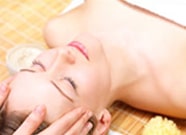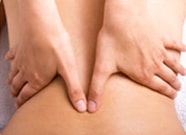 Dr. Tiffany Huggins focuses a large a part of her practice on providing soft tissue therapy along with traditional Chiropractic Spinal Adjustments. She uses a range of Trigger Point work, along with muscle stripping, and the active procedure of the shortening and lengthening of muscles while voiding the area of built-up scar tissue. She often proceeds the treatment with a heat therapy to relax the muscle and prepare it for deeper techniques and finishes with a cooling balm to soothe the muscles post-care. Dr. Huggins uses a variety of adjunct modalities such as IFC, TENS, Ultrasound, and more to help better treat your condition. Treatments are customized to suit your condition and pain level.
Dr. Tiffany Huggins focuses a large a part of her practice on providing soft tissue therapy along with traditional Chiropractic Spinal Adjustments. She uses a range of Trigger Point work, along with muscle stripping, and the active procedure of the shortening and lengthening of muscles while voiding the area of built-up scar tissue. She often proceeds the treatment with a heat therapy to relax the muscle and prepare it for deeper techniques and finishes with a cooling balm to soothe the muscles post-care. Dr. Huggins uses a variety of adjunct modalities such as IFC, TENS, Ultrasound, and more to help better treat your condition. Treatments are customized to suit your condition and pain level.
 MRT is essentially the assessment and manipulation of the soft tissues and joints of the body. This includes the skin, muscles, tendons, fascia, ligaments, and joint capsules. These areas are assessed and treated by hand with each technique appropriate to each patient’s condition and comfort. MRT works best when the therapist is able to make direct contact with the skin. For this reason many patients are intimidated by the process, here at OCC our patients are able to remove as much or as little clothing from the area that they wish and will always be provided with a gown. If the lower limb is involved, athletic shorts are recommended during treatment for comfort and accessibility. This ensures our patients the highest comfort possible.
MRT is essentially the assessment and manipulation of the soft tissues and joints of the body. This includes the skin, muscles, tendons, fascia, ligaments, and joint capsules. These areas are assessed and treated by hand with each technique appropriate to each patient’s condition and comfort. MRT works best when the therapist is able to make direct contact with the skin. For this reason many patients are intimidated by the process, here at OCC our patients are able to remove as much or as little clothing from the area that they wish and will always be provided with a gown. If the lower limb is involved, athletic shorts are recommended during treatment for comfort and accessibility. This ensures our patients the highest comfort possible.
Dr. Huggins will use a type of oil or cream to prevent irritation across the skin’s surface. If you are aware of any allergies you may have to lotions or oils, it is imperative that you let us know before treatment so a supplement can be provided.
The short term benefits of MRT can include a decrease in pain, inflammation, swelling and spasms. In addition trigger point methods combined with hydrotherapy can maintain a greater range of motion in the cervical spine.
Long term benefits include the elimination of adhesions, an increase in the motion of joints, the strengthening of muscles, address compensatory changes, as well as accompanying signs and symptoms.
Like all activities attributing to the soft tissue, there is some risk involved. These may include muscles stiffness/soreness the next day, an aggravation of symptoms, imbalance of medications (insulin) and discomfort between treatments. This being said the benefits include relaxation and decreased stress, along with increased motion and elimination.
Dr. Huggins may give you instructions of hydrotherapy to use at home. This can range from full body hydrotherapy (i.e. Epson salt bath), or a locally applied therapy (i.e. heating pad or ice). This self-care supports the soft tissue work done by your doctor and may help to alleviate pain or discomfort due to your injury.
Remedial exercise is another form of self-care for the client to use at home to aid in their recovery. These remedial exercises can include stretches or strengthening exercises for the muscles. It is important that clients become active participants in their own health and recovery, and doing these prescribed remedial exercises can help to quicken the client’s recovery time.
Myofascial trigger points reduce full range of motion by preventing full lengthening of the muscle. A trigger point is defined by Travel and Simons as a hyperirritable spot within a taut band of skeletal muscle or it’s fascia, that is painful on compression. It can refer to pain to other areas of the body. If it is painful within a referral zone, it is known as active. If it refers to pain only when it is compressed, it is known as latent.
Within the first four days of injury. Symptoms seen may include one or all of the following: pain, swelling, an increase in temperature at the injury site, redness, loss of movement, muscle spasming.
Within the fourth and fourteenth day after the injury. Symptoms seen may include one or all of the following: some decrease in pain, some decrease in swelling, increased muscle weakness, decreased range of motion due to adhesion formation.
Fourteen to twenty-one days after the injury. There may be restriction of movement due to scar and adhesions, pain and muscle weakness can be present but inflammation is absent. Although chronic inflammation can last for weeks or years, especially after reoccurring flare-ups of acute inflammation (i.e. tendonitis).
BackFree Consultation